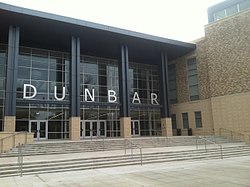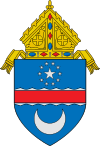
Sterling Allen Brown was an American professor, folklorist, poet, and literary critic. He chiefly studied black culture of the Southern United States and was a professor at Howard University for most of his career. Brown was the first Poet Laureate of the District of Columbia.

The University of the District of Columbia (UDC) is a public historically black land-grant university in Washington, D.C. It was established in 1851 and is the only public university in the city. UDC is a member school of the Thurgood Marshall College Fund. The full university system offers workforce and certificate programs in addition to Associate, Baccalaureate, Master's, professional, and Doctoral degrees. The university's academic schools and programs include the UDC Community College, College of Arts and Sciences, School of Engineering and Applied Sciences, School of Business and Public Administration, Colleges of Agriculture, Urban Sustainability & Environmental Sciences, and David A. Clarke School of Law.

Mary Terrell was an American civil rights activist, journalist, teacher and one of the first African-American women to earn a college degree. She taught in the Latin Department at the M Street School —the first African American public high school in the nation—in Washington, DC. In 1895, she was the first African-American woman in the United States to be appointed to the school board of a major city, serving in the District of Columbia until 1906. Terrell was a charter member of the National Association for the Advancement of Colored People (1909) and the Colored Women's League of Washington (1892). She helped found the National Association of Colored Women (1896) and served as its first national president, and she was a founding member of the National Association of College Women (1923).

Oakland Technical High School, known locally as Oakland Tech or simply "Tech", is a public high school in Oakland, California, United States, and is operated under the jurisdiction of the Oakland Unified School District. It is one of six comprehensive public high school campuses in Oakland. Oakland Tech's attendance jurisdiction includes several neighborhoods, including Oakland Chinatown, Rockridge, North Oakland, and Temescal.

Schenley High School, located in the North Oakland neighborhood at the edge of the Hill District in Pittsburgh, Pennsylvania, is a historic building opened in 1916 that was a part of the Pittsburgh Public Schools. The Schenley High School building was closed in June 2008 in a 5–4 vote by the school district due to issues with asbestos. Its staff and students were relocated the following year. The Schenley name was retired and its last class graduated in 2011. On February 28, 2013 the Pittsburgh School Board approved the sale of Schenley High School to the PMC Property Group of Philadelphia in a 5–4 vote.

Booker T. Washington High School is a high school in Tulsa, Oklahoma. It was named after the African-American education pioneer Booker T. Washington. It is part of the Tulsa Public Schools system.
Farragut Career Academy High School is a public 4–year high school located in the Little Village neighborhood on the West Side of Chicago, Illinois, United States. As a career academy, Farragut emphasizes a curriculum that combines academic instruction with work-study experiences and vocational training. In addition to Education-To-Careers clusters, Farragut is also home to the General Patton JROTC program, which functions as a school-within-a-school.
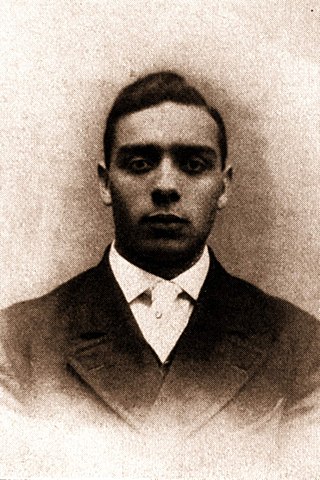
Edwin Bancroft Henderson, was an American educator and National Association for the Advancement of Colored People (NAACP) pioneer. The "Father of Black Basketball", introduced basketball to African Americans in Washington, D.C., in 1904, and was Washington's first male African American physical education teacher. From 1926 until his retirement in 1954, Henderson served as director of health and physical education for Washington, D.C.'s black schools. An athlete and team player rather than a star, Henderson both taught physical education to African Americans and organized athletic activities in Washington, D.C., and Fairfax County, Virginia, where his grandmother lived and where he returned with his wife in 1910 to raise their family. A prolific letter writer both to newspapers in the Washington, D.C., metropolitan area and Alabama, Henderson also helped organize the Fairfax County branch of the NAACP and twice served as President of the Virginia NAACP in the 1950s.

Mary Jane Patterson was an American educator born to a previously enslaved mother. She is notable because she is claimed to be the first African-American woman to receive a B.A degree. In 1862, she completed the four-year 'gentlemen's course' at Oberlin College. She first taught at the Philadelphia's Institute for Colored Youth. She then went on to teach at the Preparatory High School for Colored Youth, known today as Dunbar High School, in Washington, D.C.. She became its first Black principal. She was a lifelong advocate for Black education, helping to found the Colored Woman's League which later became the National Association of Colored Women. A humanitarian, Patterson also devoted time and money to Black institutions in Washington, D.C.

Joel Elias Spingarn High School was a public high school located in the District of Columbia, USA. The school is named after Joel Elias Spingarn (1875–1939) an American educator and literary critic who established the Spingarn Medal in 1913, awarded annually for outstanding achievement by an African American.

Paul Laurence Dunbar High School is a public high school in Baltimore, Maryland, United States.

Paul Laurence Dunbar High School is part of Dayton City Schools. The school is located in Dayton, Ohio, and serves approximately 550 students. The school is named after poet Paul Laurence Dunbar, a Dayton native. The school mascot is the wolverine.

The District of Columbia Interscholastic Athletic Association (DCIAA) is the public high school athletic league in Washington, D.C. The league was founded in 1958. The original high school conference for D.C. schools was the Inter-High School Athletic Association, formed around 1896. That organization was segregated, and black schools in the District formed their own athletic association. The Inter-High League was renamed the DCIAA in 1989 to bring the District of Columbia in line with other states with interscholastic athletic programs. The DCIAA offers sports on the elementary, middle and high school levels.

Julia Evangeline Brooks was an incorporator of Alpha Kappa Alpha Sorority, Incorporated, the first sorority founded by African-American women. The sorority has continued to generate social capital for nearly 100 years.
Mary P. Burrill was an early 20th-century African-American female playwright of the Harlem Renaissance, who inspired Willis Richardson and other students to write plays. Burrill herself wrote plays about the Black Experience, their literary and cultural activities, and the Black Elite. She featured the kind of central figures as were prominent in the black society of Washington, D.C., and others who contributed to black women's education in early twentieth century.
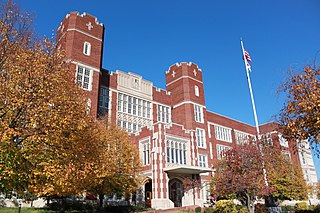
Eastern High School is a public high school in Washington, D.C. The school is located on the eastern edge of the Capitol Hill neighborhood, at the intersection of 17th Street and East Capital Street Northeast. Eastern was a part of the District of Columbia Public Schools restructuring project, reopening in 2011 to incoming first-year students and growing by a grade level each year. It graduated its first class in 2015. In addition, Eastern was designated an International Baccalaureate school in 2013 and awarded its first IB diploma in 2015. As of the 2022–2023 school year, it educates 766 students in grades 9 through 12.

M Street High School, also known as Perry School, is a historic former school building located in the Northwest Quadrant of Washington, D.C. It has been listed on the District of Columbia Inventory of Historic Sites since 1978 and it was listed on the National Register of Historic Places in 1986. The building escaped demolition with community support and the efforts of preservationists and is now a community center.

Robert Heberton Terrell was an attorney and the second African American to serve as a justice of the peace in Washington, DC. In 1911 he was appointed as a judge to the District of Columbia Municipal Court by President William Howard Taft; he was one of four African-American men appointed to high office and considered his "Black Cabinet". He was reappointed as judge under succeeding administrations, including that of Democrat Woodrow Wilson.
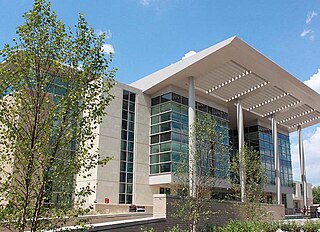
Howard Dilworth Woodson High School is a secondary school in Washington, D.C. that serves grades 9 through 12. It is located in the Northeast Boundary neighborhood, at the intersection of 55th and Eads Streets NE. It is a part of the District of Columbia Public Schools and primarily serves students in Ward 7. The current principal is William Massey.

Jane Eleanor "Nellie" Datcher was an American botanist and the first African-American woman to earn an advanced degree from Cornell University in 1890. She worked as a teacher at Dunbar High School in Washington, D.C. and was a founding member of the Collegiate Alumnae Club.
